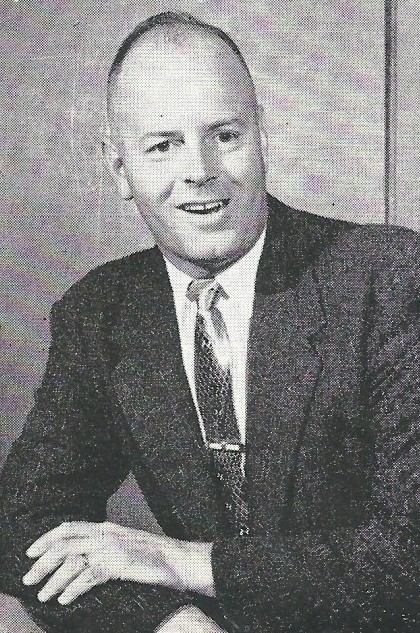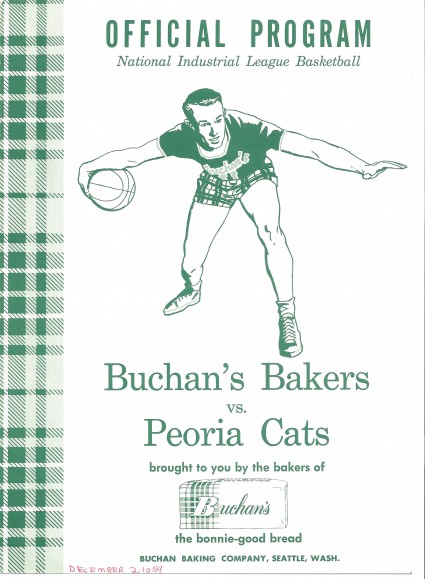About: Press
- What Others Are Saying
-
Wayback Machine: A Bakery That Cooked Up Basketball
By David Eskenazi 11:00AM 06/07/2011
In the time before the NBA, Seattle's Buchan Bakers were an AAU powerhouse that featured the region's premier hoops players post-college.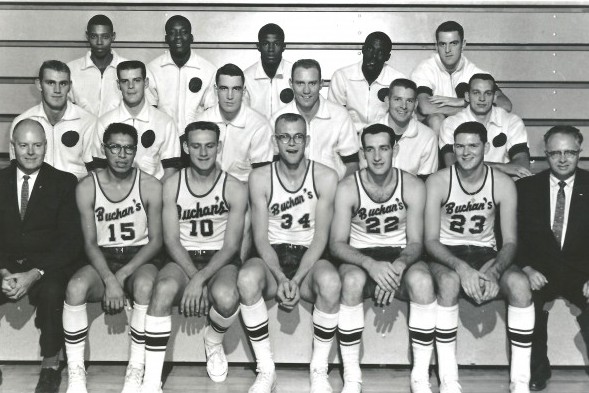
The last edition of the Buchan Bakers (1960-61). Front row, left to right: Bud Howard (business manager), Chief Williams, Bob McLaughlin, Dick Brott, Don Woodworth, Pete Gaudin, Gene Johnson (head coach); Middle Row (L to R): John Maras, Bennie Coffman, Pete McCaffrey, Leon Hill, Tom Rowan, Frank Potter; Top Row (L to R): Bob Failes, Al Abram, Bob Sims, Ruben Young, Dick Gregory. / David Eskenazi Collection
By David Eskenazi and Steve Rudman
Anyone who strolled a Seattle, Tacoma or Bellingham street from the late 1920s through the mid-1960s would have been familiar with the fleet of automobiles (originally Model-T Fords) and delivery trucks operated by the Buchan Baking Company, a Wallingford-based maker of bread and other bakery products.
On the side of those trucks, as well as on numerous billboards and window signs, Buchan mainly touted its iron-fortified, white enriched bread, sealed in a plastic wrapper with a distinctive red and green Tartan band, as The Good Bread, Bonnie Good Bread and The Bread of Basketball Champions.
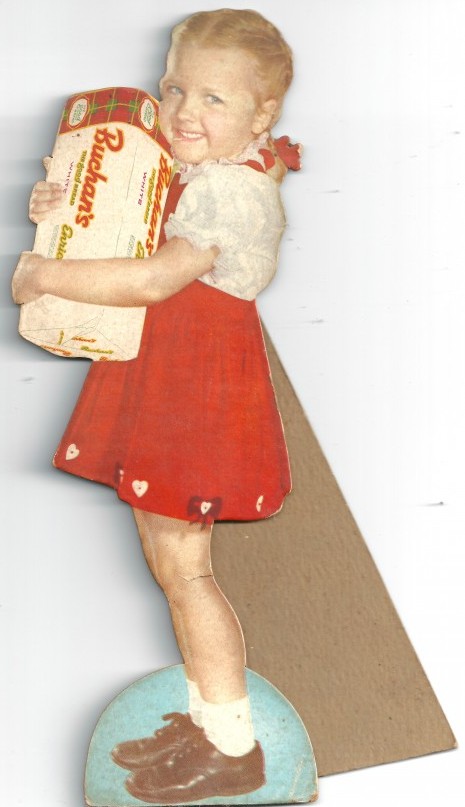
A 1940s cardboard counter display advertising Buchan Baking Company's signature bread. / David Eskenazi Collection The basketball champions in question, the Buchan Bakers (pronounced both Bew-can and Buck-can during the teams existence), represented the bakery in the regional Northwest AAU League from 1948 through 1957, and in the National Industrial Basketball League from 1958 through 1961. They came to national prominence in 1956 by winning the national AAU Tournament>as a huge underdog, and then becoming the first U. S. team, pro or amateur, to play behind the Iron Curtain.Except for the years 1951-53, when Bob Houbregs and the OBrien twins ( and Eddie) starred at the University of Washington and Seattle University, respectively, and 1956-58, when Elgin Baylor certified himself a Chieftains legend, the Buchan Bakers played the highest quality of basketball in the Northwest, largely with players who had exhausted their eligibility at local colleges and universities.
During that pre-NBA era, athletes who left college before the formations of the American Basketball League (1961) and American Basketball Association (1967) did not have many options if they wished to continue playing.
They could try to make a professional (Basketball Association of America or National Basketball League) roster, but jobs were scarce. They could also join the semi-pro Eastern League, or they could play AAU ball.
In the late 1940s, the Basketball Association of America (renamed the National Basketball Association in 1949-50 after it merged with the National Basketball League had only eight franchises, none west of Chicago or south of St. Louis.
Since most Eastern League teams were in Pennsylvania, that left plenty of geography to occupy.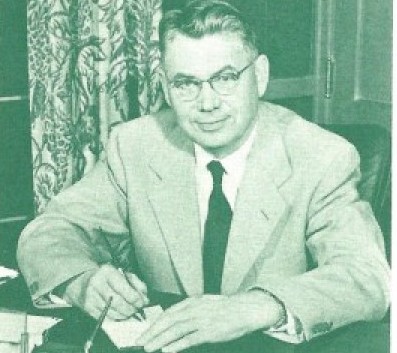
George B. Buchan, owner of Buchan Baking Company. / David Eskenazi Collection
The Amateur Athletic Union (which governed almost all amateur athletics in the United States from 1936-68), sporting hundreds of teams and willing corporate sponsors, claimed a great part of that landscape.Strong in the Midwest, Southwest and West Coast, obviously where pro basketball had not yet established a presence, AAU ball made a lot of sense for players unable or unwilling to turn professional. The AAU offered a high level of competition and allowed players to retain their amateur status and, thus, their eligibility for the Olympic Games.
As important, corporations sponsored many AAU teams and provided jobs and management training to the players in their employ. In many cases, a player could make more in cash and benefits playing for an AAU team than he could playing pro basketball, which, in those days, offered little of either.
In 1956, the Minneapolis Lakers made Terry Rand, a forward out of Marquette, their second-round draft choice. The Lakers, who had no TV income and were nearly bankrupt, offered Rand a one-year, $7,500 contract, decent for the day.
An AAU team, Denver-Chicago Trucking, offered Rand $400 per month to work for the company, an opportunity to train for an executive position, fringe benefits and a large signing bonus. Under this arrangement, Rand technically remained an amateur, according to the AAU, which had say-so in
such matters.Denver-Chicago Trucking also offered Rand an employment opportunity after his basketball career ended. With an eye on future security, Rand elected to play for Denver-Chicago Trucking instead of the Lakers, who might have gone belly-up if Elgin Baylor hadn't signed with them two years later.
Through similar enticements, AAU teams lured numerous All-Americans away from professional basketball, notably Bob Kurland, an All-America at Oklahoma A&M, who had helped the Aggies win consecutive NCAA titles in 1945-46.
Kurland played six years with the Phillips Petroleums AAU entry, the Phillips 66 Oilers. During that time, he made appearances in the 1948 and 1952 Olympic Games. Kurland spent his post-basketball career working for Phillips, and never would have had that kind of security in the NBA of his day.
Other top collegians started out playing AAU ball and turned professional when the NBA came into existence and began paying better wages. Among the most prominent: Andy Phillip (Fleet Mariner Force), K.C. Jones (Ft. Leonard Wood), George Yardley (San Francisco Stewart Chevrolet), Jim Pollard (Oakland Bittners) and Elgin Baylor (Westside Ford), all eventually Naismith Hall of Famers.
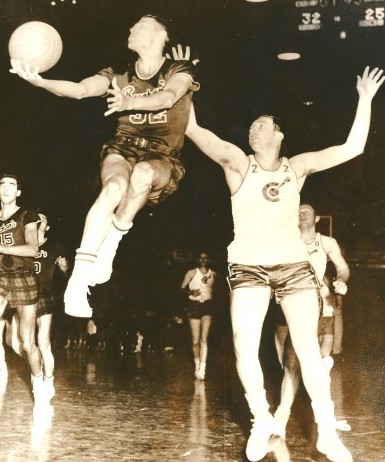 Former UW star Chuck Koon helped the Bakers win the 1956 AAU Tournament in Denver. In this
photo, Koon drives for layup against Denver Central Insurance. Guarding him is Denver's Tom
Bowman. Phil Jordon (15) of Buchan trails the play. / David Eskenazi Collection
Founded in 1913 by Scottish immigrant George Buchan, who worked in several New England
bakeries until 1907 when he moved to Seattle, the Buchan Baking Company employed only a
couple of hundred people in Western Washington and didnt have the financial clout to compete for
players with the likes of big AAU sponsoring companies such as Phillips Petroleum and Goodyear (Akron Goodyears).
Former UW star Chuck Koon helped the Bakers win the 1956 AAU Tournament in Denver. In this
photo, Koon drives for layup against Denver Central Insurance. Guarding him is Denver's Tom
Bowman. Phil Jordon (15) of Buchan trails the play. / David Eskenazi Collection
Founded in 1913 by Scottish immigrant George Buchan, who worked in several New England
bakeries until 1907 when he moved to Seattle, the Buchan Baking Company employed only a
couple of hundred people in Western Washington and didnt have the financial clout to compete for
players with the likes of big AAU sponsoring companies such as Phillips Petroleum and Goodyear (Akron Goodyears).
But Warren (Bud) Howard, a Seattle-based oil company purchasing agent who graduated from Washington State University, convinced Colin Buchan, son of George B. Buchan and grandson of the company founder, that sponsoring a city-based AAU team would not only provide his business with an unprecedented advertising opportunity, but establish a training ground for future Buchan Bakery employees.
It soon became policy for Buchan to hire individuals primarily on the basis of their promise as employees, and not primarily on their potential as basketball players (still, tall candidates had a decided edge over short candidates).
Starting with a 20-game schedule, the Bakers launched in 1948 against a circuit of similar amateur clubs in the Seattle area, including Westside Ford, Puhich Cleaners, Darigold Farms, Federal Old Line Insurance, Fort Lawton and Val Kirk Pharmacy.
Clad in high, white canvas sneakers and green and red plaid shorts that matched the Tartan design on wrappers that Buchan used for its bread products, the Bakers didnt do much for their first three seasons.
But in 1951-52, after adding center Rod Gibbs from the College of Puget Sound and 5-7 guard Dar Gilchrist from Long Island University to a team that already included ex-Huskies Lou Soriano and Jack Ward, the Bakers won the Northwest AAU title and qualified for the national AAU Tournament in Denver for the first time.
After the Bob Houbregs-led Huskies reached the NCAA Final Four in 1953, Howard began an earnest recruitment of their graduating players. He managed to get Houbregs name on a contract, briefly making Houbregs a Buchan Baking Company employee, but Houbregs ultimately opted to play to the NBA.
As a consolation, Howard signed four other Husky players from the 1953 Final Four team, including Charlie Koon, Joe Cipriano, Mike McCutcheon and Doug McClary, and enlisted another former Husky, Bill Morris, to become the teams new head coach (Howard wanted to focus his efforts on recruiting new players). The Bakers again qualified for the AAU Tournament in Denver, but lost in the first round.
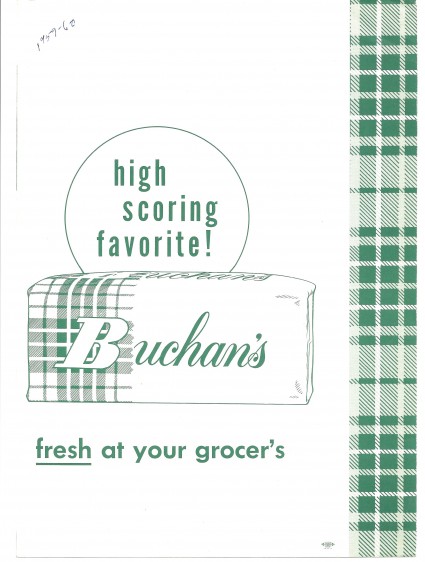
The back of the Buchan-Peoria program cover touted Buchan Baking Company's bread, enclosed in the distinctive Tartan wrapper. / David Eskenazi CollectionAfter Morris elected to return to Washington, Howard signed Frank Fidler to take over the teams head coaching duties. A 1942 graduate of Appalachian State Teachers College, Fidler served in the Air Force during World War II and joined the Seattle School District after returning to Seattle, starting out as a teacher and basketball coach at Garfield High School.
(After coaching the Bakers, Fidler became the principal at several Seattle high schools, notably Roosevelt from 1970-77, officiated football and basketball games at the high school and collegiate levels, and helped establish the Washington State High School Officiating Association).
Under Fidler, the Bakers won a first-round game at the AAU Tournament in 1955, but lost to the Peoria Cats in double overtime in a quarterfinal game.
In Fidlers second year, the Bakers produced the best regular season in franchise history (16-2) after Howard acquired 6-10 center Phil Jordon, who later played in the NBA; George Swyers, the NAIAs No. 3 scorer out of West Virginia Tech; forward Dean Parsons from Washington, and Stan Glowaski, a 6-5 guard from Seattle University.
Howard now had the nucleus of a championship team. Koon and Cipriano were adept ball handlers, and Glowaski, the third guard, a strong scorer. Forwards Ed Halberg (University of Oregon) and Frank Guisness (UW) and center Parsons (UW) provided inside depth on the front line.
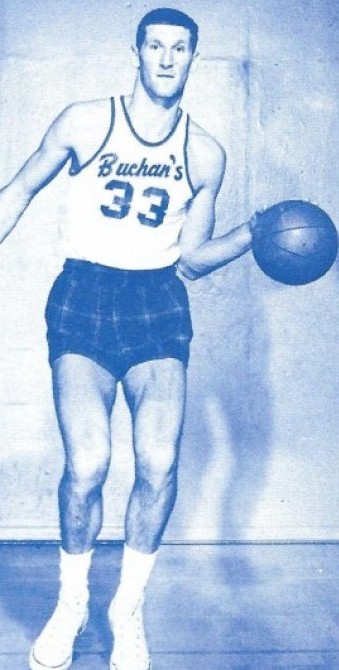
University of Washington star Bruno Boin (the Jon Brockman of his day) played a key role in Buchan's 1956 national AAU title (the Tartan shorts mimicked Buchan's bread wrappers). / David Eskenazi CollectionThis Bakers team also traveled to Asia to play clubs from Japan, China and the Philippines, developing a chemistry that prepared the Bakers for their third try at the national title a run, by the way, nearly derailed by Elgin Baylor, then playing for Westside Ford while waiting to become eligible to play at Seattle U.
Averaging more than 30 points per game, Baylor led Westside Ford to a pair of regular-season victories over the Bakers, and the teams finished tied for the Northwest AAU League regular-season title with 15-2 records.
In a playoff game on March 3 to determine the league winner, Baylor scored 35 points, but Buchan prevailed 98-70.
Even with the victory, Buchan was given little chance to do much in the AAU Tournament in Denver.
Before traveling there, where Buchan was slotted against Denver Central Insurance, the Pasadena Mirror-Glazers, Allen-Bradley of Milwaukee and the defending national champion Phillips 66 Oilers, the Bakers made a key addition, Bruno Boin, then a sophomore center at the University of Washington.
Boin made significant defensive contributions in Baker wins over Denver Central Insurance (71-57) in the first round and the Mirror-Glazers (68-64) in the second round. Boin then made a huge difference in the semifinals, scoring 17 points, mostly on hook shots, in an 85-75 victory over Allen-Bradley of Milwaukee.
On March 24, with Luke Sewell taking the Rainiers through spring training, Darrell Royal settling in as the new UW football coach, and Seattle U. seeking a replacement for just-resigned basketball coach Al Brightman, the Bakers met the heavily favored and defending tournament champion Phillips 66 Oilers for the national AAU title in the Denver Civic Auditorium.
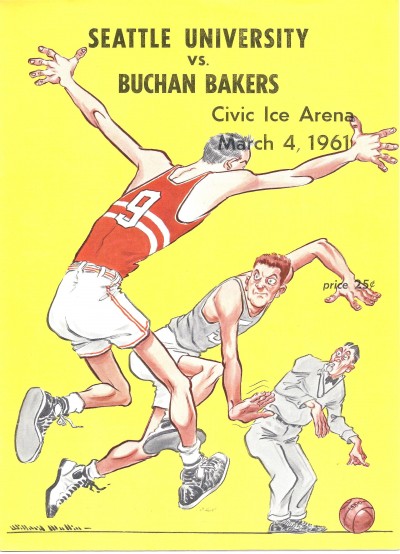
The Bakers played Seattle University several times. This is a program cover from the March 4, 1961 game at Civic Ice Arena. / David Eskenazi CollectionPhillips raced to a 10-2 lead, but Buchan closed the gap and the game remained tight throughout. With the scored tied at 57 and 2:24 left on the clock, Fidler ordered his players to hold the bal for the last shot.
Swyers nailed it from 12 feet as the clock expired, giving Seattle the championship, and providing the AAU Tournament with one of the biggest upsets in its history.
The team that delivered Seattles first national and professional — basketball crown included a fuel company salesman (Guisness), a man who sold trailer parts (Halberg), six Buchan Baking Company employees (Koon, Cipriano, Parsons, Jordon, Swyers and Glowaski), and two college students (Boin and Jim Coshow).
Those job descriptions would have profiled many AAU teams in the 1950s.
By capturing the national AAU title, the Bakers qualified to participate in a round-robin tournament in Kansas City to determine the Olympic team that would compete in Melbourne, Australia, in the fall of 1956.
Before entering that round robin, the Bakers traveled to Europe for a series of exhibition games in France, Spain and Italy. The Bakers then moved on to Czechoslovakia and Poland, becoming the first U.S. team, amateur or pro, to compete behind the Iron Curtain.
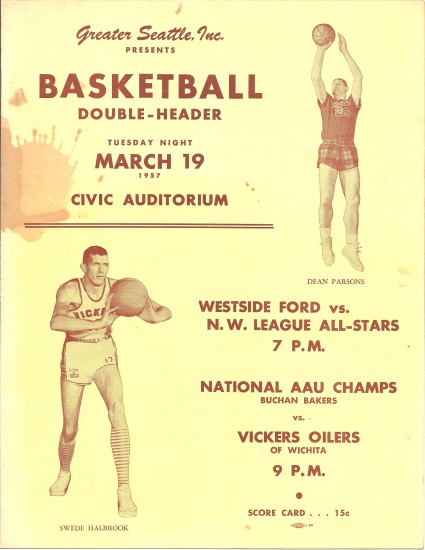 Program cover from a 1957 Civic Auditorium doubleheader featuring three Northwest AAU teams
plus the NIBL's Wichita Vickers. Cover boys Dean Parsons came to Buchan from the UW,
Halbrook to Wichita from Oregon State. / David Eskenazi Collection
Program cover from a 1957 Civic Auditorium doubleheader featuring three Northwest AAU teams
plus the NIBL's Wichita Vickers. Cover boys Dean Parsons came to Buchan from the UW,
Halbrook to Wichita from Oregon State. / David Eskenazi Collection
Taking part in the U.S. Olympic Trials upon their return from overseas, the Bakers faced off against the three top amateur squads in the United States the Phillips 66 Oilers, runnerup to Buchan at the AAU tournament; the College All-Stars, and the Armed Forces All-Stars.
The winner of the round-robin event would provide most of the players to the U.S. Olympic team (up to five), with the second-, third- and fourth-place teams providing the balance of the Olympic roster.
Maybe overseas travel got to them, but the Bakers couldnt duplicate their Denver heroics. In the first round, they lost to a College All-Star team featuring Bill Russell (24 points) and future Sonics coach K.C. Jones (18 points) 86-79, and then lost to Phillips in a rematch of the AAU title game, 72-64.
In a game for third place, the Bakers defeated the Armed Forces All-Stars 82-79 (the Armed Forces All-Stars featured Al Bianchi, who would become the first coach of the Seattle SuperSonics in 1966-67). Phillips won the tournament and landed five players on the Olympic team. The only Buchan player to make it: Dick Boushka, who had joined Buchan specifically for the Olympic Trials.
In 1956-57, Jordon departed the Bakers for the NBA, Swyers jumped to the Akron Goodyears, Cipriano began his coaching career and Boin returned to the University of Washington, leaving the Bakers with just three key operatives from their championship team, Koon, Halberg, and Parsons. The Bakers never again mounted a serious challenge for an AAU title.

Interior program roster for Civic Auditorium doubleheader. Note that Buchan features five players from UW. Wichita features former Oregon State star Wade "Swede" Halbrook, a 7-3 center who later played in the NBA. / David Eskenazi CollectionThey couldnt even defeat Seattle University one year after claiming the championship. On Jan. 29, 1957, in front of a standing-room-only throng of 6,133 at Civic Arena, the Bakers lost to the Chieftains (more than 1,000 fans were turned away) 76-73 as sophomore Elgin Baylor went for 29 points.
Needing to beef up their schedule in order to attract better players, the Bakers departed the Northwest AAU League after the 1957-58 season and joined the higher profile National Industrial Basketball League, which included the Denver-Chicago Truckers, Wichita Vickers, Phillips 66 Oilers, Akron Goodyear Wingfoots (longtime NBA coach Larry Brown played for Akron), and Peoria Cats.
The switch to the NIBL backfired. The Bakers never again had a winning season, going 10-20 (1958-59), 14-18 (1959-60) and 10-24 (1960-61), despite featuring two All-Americans during that time, Carroll Williams (later became the winningest head coach in Santa Clara history) and Rolland Todd (later the first head coach of the expansion Portland Trail Blazers).
Todd helped Buchan win a marquee, non-AAU game on Dec. 10, 1959 (the game launched the 1959-60 season). The Bakers were selected as one of six U.S. opponents for the touring USSR National Team, preparing for the 1960 Olympic Games in Rome.
In front of 4,000 fans at Hec Edmundson Pavilion, Todd scored the clinching basket with 16 seconds to play as the Bakers beat the Soviets 78-74.
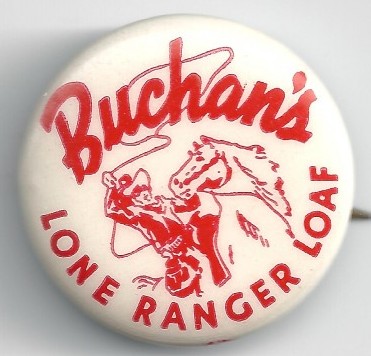
In the 1950s, Buchan Baking Company developed a marketing agreement with the popular 1950s TV series, "The Lone Ranger," producing souvenir pinback buttons which promoted its bread products. / David Eskenazi CollectionUnfortuntely for the Bakers, AAU opponents gave them more than they handle as the 1960s dawned.
Due to the poor records, Howard found it almost impossible to recruit top local players to the club (in fact, he signed no new ones for what proved to be their final season) and, as a consequence, attendance, never great, dried up.
The final game in Buchan Bakers history occurred on March 23, 1961, when the Bakers lost to the Denver-Chicago Truckers in the quarterfinals of the national AAU Tournament.
For a few weeks after the tournament, Howard attempted to find financial support beyond the Buchan Baking Company to keep the team afloat, but could not.
In April (1961), the NIBL dropped the Bakers from league membership, and then the league itself disbanded operations, a victim of basketballs changing landscape.
At its height, the National Industrial League played at a level a cut above the collegiate brand and only a thin slice below the precision of the best pros.
But the leagues appeal began to wane after the NBA started to sign players such as Bill Russell, Wilt Chamberlain, Elgin Baylor, Oscar Robertson and Jerry West.
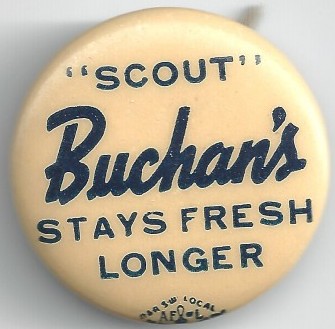
Buchan's tie-in with the "Lone Ranger" TV series also included a pinback buttom for "Scout," the horse ridden by the Lone Ranger's sidekick, Tonto. / David Eskenazi CollectionThe NBA had also started to stabilize itself financially, and as it offered higher and higher salaries, attracting better and better players, AAU teams became increasingly irrelevant.
AAU teams made their own miscalculations. Many of the sponsoring companies refused to offer management-training opportunities to African American athletes (the Civil Rights Act was still three years away), and thus the best players wouldnt work for them. The falling dominoes from that policy put the AAU out of business in 1968.
Robin Buchan, son of Buchan Baking Company leader George B. Buchan, and Bruce Kitts, George B. Buchans grandson, wrote a book in the mid-2000s titled Long shot: The Story of the Buchan Bakers.
Its an excellent history well written and superbly researched — in which the authors parsed all aspects Buchan Bakers history. Included in their work:
– The Bakers won six consecutive Northwest AAU League titles between 1951-58, and participated in the national AAU Tournament in Denver nine times.
– After the Bakers folded, seven of their former players found jobs in Abe Sapersteins innovative American Basketball League (1961, when the 3-point shot was developed), including R.C. Owens, who also went on to play in the National Football League, principally for the San Francisco 49ers.
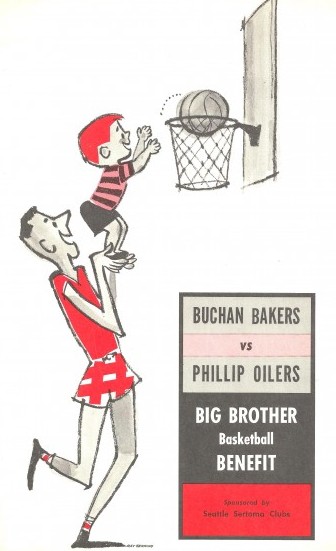
The Bakers played numerous exhibition contests during their 13-year existence, including a benefit game against the Phillips 66 Oilers. This is a program cover from that game. / David Eskenazi Collection– George Bayer, who spent the 1949-50 campaign with Buchan, became a prominent player on the PGA Tour, winning four tournaments, including the Canadian Open.
– The NBA drafted more than 20 Buchan Baker players between 1951-60, the vast majority of them late-round picks.
– Four Buchan Bakers players earned AAU All-America recognition while representing the bakery: Charlie Koon (1956), R.C. Owens (1957), Carroll Williams (1960) and Rolland Todd (1960).
– Nine ex-UW players played for Buchan at some point after leaving school, including five from the 1953 Final Four team.
– Three members of the 1958 Seattle U. team that lost to Kentucky in the NCAA championship game later played for Buchan.
– Five individuals who played for the Bakers saw time in the NBA, including Dwight Morrison, a 6-8, forward-center from Idaho; Arlen Bockhorn, a 6-4 forward from the University of Dayton; Phil Jordon, the 6-10 center from Whitworth who helped the Bakers win the 1956 AAU national title; Bob Sims, a 6-5 guard from Pepperdine, and John Tresvant, a 6-7 forward-center from Seattle University. Tresvant played with Buchan briefly in 1960-61 after leaving the Chieftains. Tresvant spent nine seasons in the NBA after going to the St. Louis Hawks in the fifth round of the 1964 NBA Draft and also played for the Detroit Pistons, Cincinnati Royals, Los Angeles Lakers and Baltimore Bullets (an interesting note by the authors: Tresvant is the only player to have played for the Buchan Backers and the Seattle SuperSonics).
Tresvant is also famous in Seattle University lore for having pulled down 40 rebounds in a game against Montana State in 1963, the fourth-highest total in NCAA history.
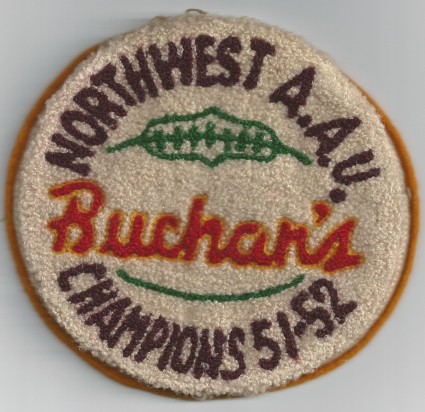
After the Bakers won the Northwest AAU title in 1951-52, the club's first such championship, Buchan issued these cool jacket patches. / David Eskenazi Collection– The Bakers had four head coaches. In addition to Howard, Morris and Fidler, Gene Johnson, a McPhersons's realtor, coached the Bakers over their final two seasons. Credited with inventing the full-court press, Johnson had been the head basketball coach at Wichita State and for numerous AAU teams (Johnson also served as an assistant coach of the 1936 U.S. Olympic team that won a gold medal in Berlin, and as head football coach at Kansas Wesleyan University).
Even if the NBA hadnt taken over the national basketball spotlight, and even if the Bakers fielded respectable teams after joining the NIBL, changes in the underlying bakery business probably would have doomed them anyway.
In the spring of 1966, the Buchan Baking Company, facing increased competition, merged with Portland-based Orowheat (national headquarters: Los Angeles). Within a few years, Orowheat dropped the Buchan name and the enterprise became Orowheat Bakery.
Today, the brick building where Scottish immigrant George B. Buchan once produced The Good Bread and Bonnie Good Bread with that distinctive green and red Tartan wrapper design is the site of the Wallingford Café.
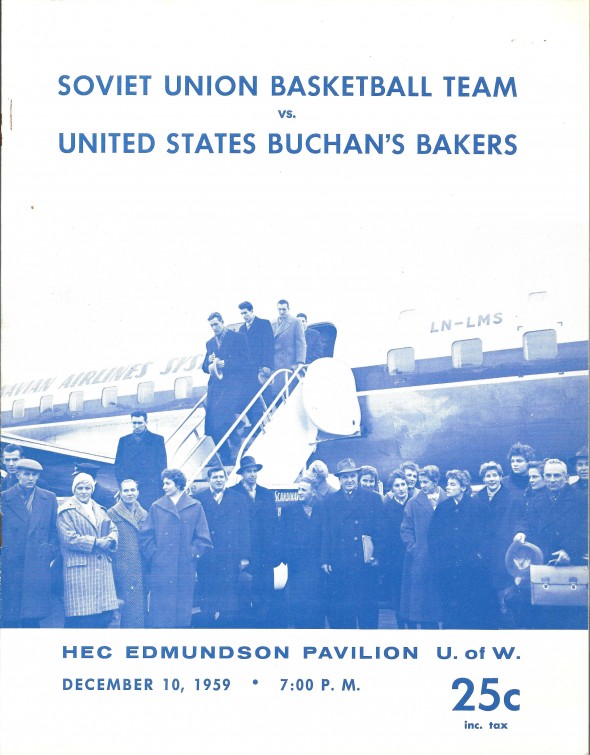
Program cover from the Bakers' game against the touring USSR National Team. The Bakers defeated the Soviets in a close contest. / David Eskenazi CollectionDavid Eskenazis Wayback Machine Archive. David can be reached at (206) 441-1900, or at seattlesportshistory@gmail.com
From the King County Journal, 10/26/2004:
Homegrown heroes: Buchan Bakers overcame odds to win 1956 national title
by Jim Cnockaert
Journal Sports EditorThe players wore plain white, canvas high-top sneakers and plaid shorts that actually were short, and they worked day jobs before ever setting foot on the basketball court.
Their team, not unlike those today in smaller professional sports markets, was owned by a local businessman who had to find creative ways to stay competitive because he could not match the resources of other owners.
But long before the SuperSonics and the Storm, the Buchan Bakers, nicknamed for the Seattle bread company that sponsored them, brought basketball fame to the Emerald City.
During a decade when amateur, not professional, athletics captured most of the nation's sporting attention, the Bakers won the 1956 Amateur Athletic Union national championship. They did it with a stunning, last-second victory against the dominant team of that era, the Phillips 66ers of Bartlesville, Okla.
The Bakers' history, with particular attention paid to the '56 season, is chronicled in a new book by Robin Buchan and former Journal staffer Bruce Kitts titled ``Longshot: The Story of the Buchan Bakers.'' The two will show a 30-minute film of the championship game and discuss their book at 1:30 p.m. today at the Bellevue Public Library, 1111 110th Ave. N.E. Admission is free.
Buchan is the son and Kitts is the grandson of the Bakers' late owner, George Buchan.
The NBA was founded in 1949, but it did not emerge as the nation's pre-eminent basketball league until a decade later when it began to showcase stars such as Bill Russell, former Seattle University star Elgin Baylor, and Wilt Chamberlain. Until that point, a handful of elite AAU teams dominated the sport.
For a brief time, the Bakers were one of those teams.
``They're an example of how for a long, long time the model for a basketball program was the company-sponsored industrial team,'' said Kitts, a Bothell resident. ``The company would hire the players and keep them as employees. If there was a choice between two prospective employees, the company would go with the taller one.
``These big corporations took it very seriously. The 66ers had their own gym and an apartment complex for the players, and the company had a plane that flew the team around. A lot of times, these companies would get players and run them through their management-training program. That was a big draw, and it made it difficult for the NBA to get going in those early years.''
These AAU teams played a full schedule each season, typically topping 30 games, and traveled throughout the country. Some teams also helped to introduce the American style of basketball to foreign players. During and after the 1955-56 season, the Bakers played games in the Far East and Europe. They also played in Czechoslovakia and Poland, becoming the first AAU team from the United States to play behind the Iron Curtain.
The Buchan Bakers were formed in 1948 after Warren ``Bud'' Howard convinced George Buchan and his Buchan Baking Company to sponsor his basketball team. Howard was player-coach at first, and he later became the team's general manager.
The Bakers were immediately recognized by their signature shorts, which featured a red-and-green plaid design identical to the design on wrappers the company used on its bread products. Pronunciation of the Buchan name had changed over time. The team was known as the ``Bew-can'' Bakers, but the family name originally was pronounced ``Buck-en.''
The company eventually was purchased by Oroweat.
``The team was kind of an anomaly,'' Kitts said. ``The Buchan Baking Company was not very big and did not make a lot of money, so it did not have a lot of jobs (to offer players). Fortunately, basketball is not an expensive sport to run.''
After dominating the Class AA city league in their early years, the Bakers moved into the Northwest AAU League. The Bakers reached the national tournament for the first time in 1952, but they lost in the opening round.
The 1953 University of Washington basketball team, led by All-American center Bob Houbregs, made it to the NCAA Final Four, and Howard recruited all five Husky starters. Houbregs agreed to play for the Bakers, but he changed his mind and joined the NBA's Milwaukee Hawks.
Howard did sign the four remaining Huskies -- Charlie Koon, Joe Cipriano, Mike McCutcheon and Doug McClary -- and he hired Bill Morris, the UW freshmen coach, as head coach.
Morris returned to the UW in 1954, and former high school coach Frank Fidler was hired as coach. The team fared better at the national tournament, winning its opener before losing in overtime in the second round.
Howard brought in several key players for the Bakers' championship run in 1955-56, including Phil Jordon, a 6-foot-10 center, who would play in the NBA for several years, and George Swyers, the NAIA's leading scorer from West Virginia Tech. Dean Parsons, a 6-foot-8 power forward from the UW and Stan Glowaski, a 6-foot-5 guard from Seattle University, also joined the team. For the national tournament, the Bakers added Bruno Boin, a 6-foot-9 sophomore center from the UW.
During that season, the Buchan Bakers traveled to Asia to play teams from Japan, China and the Philippines. The team chemistry developed on and off the court during that trip prepared the Bakers for their run at the national title.
``Swyers was really the final piece of the puzzle,'' said Howard, 89, who lives in Bellevue. ``We had two big guards and two quick guards, and we had good size all over.''
The Bakers opened national tournament play in Denver by defeating host Central Insurance and the Pasadena (Calif.) Mirror-Glazers to reach the semifinals against Milwaukee Allen-Bradley. Boin's long-range hook shots were the difference in an 85-75 victory that set up the championship game with the Phillips 66ers, the defending champion.
The Bakers trailed 23-12 in the first half, but they battled back to take a 31-30 half-time lead. Neither team led by more than three points in the second half. The 66ers tied the game at 57-57 with two minutes remaining.
With no shot clock to dictate the tempo of the game, the Bakers elected to play for one last shot and took a timeout in the final seconds to set up their last shot.
Appropriately, the ball wound up in the hands of Swyers, who drove into the lane, spun around a defender and threw up a one-handed shot that bounced off the backboard and into the basket as time expired.
The victory got front-page headlines in Seattle newspapers, and, while there was no victory rally as the Storm enjoyed after their recent WNBA championship, the Bakers were treated to a banquet when they returned from Denver.
The championship earned the Bakers two other honors.
Almost immediately after the season, they traveled to Europe. Later, the Bakers and the 66ers participated in the U.S. Olympic Trials. No Bakers were invited to join the U.S. team that played in the '56 Games in Australia.
The Bakers joined many of the teams it faced in the '56 AAU tournament to form the National Industrial Basketball League, but the league eventually folded in the face of a growing NBA. The reason for the NIBL's demise was simple: The best African-American players were heading to the NBA.
``In the 1950s, many of the companies that sponsored these teams did not consider recruiting African-Americans for their management training programs,'' Kitts said. ``That idea was still 20 years away. As the NBA got better, largely through integration, the industrial teams sat back and became stagnant.''
The Bakers' one African-American player was Tucker, who was stationed at Fort Lewis and taking pre-med classes at the UW. Though he was treated as just another player anywhere the team traveled in the Northwest, he was treated with great indignity during a 1955 team trip to Houston, Texas. Because of the ``separate-but-equal'' racism of the day, Tucker stayed at a local black college instead of the team hotel and could not use the same facilities as his white teammates did.
``Seattle was isolated at that time, so it did not have all the emotional racial baggage that other areas of the country did,'' Kitts said. ``You talk to former coaches and players about that, and even today there is a sense of shock about it.
``Ironically, Tucker had the game of his life down there, and he got a standing ovation.''
Robin Buchan had researched the Bakers' story for several years before asking Kitts to join the project. The two collaborated on some of the research and many interviews, and they wrote the final draft of what eventually became the 185-page paperback book printed by Classic Day Publishing.
Howard said he has read the book and is impressed with its detail.
The black-and-white film that will be show this afternoon originally was made to promote the Buchan Bread Company, and it is newsreel quality with a voice-over. It is being shown publicly for the first time since the 1950s, Kitts said.
``When I was doing the research, I came to realize that there is such a lack of information about this type of basketball,'' Kitts said. ``This helps to keep the story alive.''
From the Peoria, Ill., Journal Star, February 21, 2005
Seattle-Based Team Eventually Cooked Up Successful Recipe
By Joe Spencer of the Journal Star
BOOK REVIEW
What started as a gimmick for a regional bakery to sell more bread in Seattle blossomed into one of the great underdog stories in the history of Amateur Athletic Union basketball."Longshot: The Story of the Buchan Bakers," by Robin Buchan and Bruce Kitts (Classic Day Publishing), provides a unique glimpse into one of the winningest teams at the height of amateur basketball's national prominence during the 1950s.
In a bid to expand distribution routes around Seattle, the Buchan bakery decided to sponsor a basketball team.
Using a mix of in-state college talent, the Bakers - who represented a small company of a few hundred employees - battled teams from multi-million dollar corporations like Oklahoma's Phillips Petroleuma, Caterpillar of Peoria and Goodyear of Akron, Ohio, for years with limited success. But they beat Phillips for the 1956 national AAU title in Denver.
The authors, both relatives of Buchan Baking Company founder George Buchan, collaborate to deliver readers "a blend of company, family and team history."
"This was a way of basketball that was just as strong as the pros back in the early 1950s," Kitts said. "Robin and I felt strongly that we needed to preserve the story of the Buchan Bakers because there is very little preservation of this type of basketball out there.
"Sure, both of us had a family interest - Robin is George's son and I am George's grandson - but we are happy that there is some record of this significant time in basketball history.
"The NBA prevailed after the 1960s. But this type of basketball is just as important to the history of the sport. There is really no one left to speak for this type of basketball that was played for a half-century before the NBA, so we spoke up."
The highly readable book chronicles how Colin Buchan convinced his father, George Buchan, that a team would be "the best advertising the company could hope for."
After making a commitment to attract Washington's top-tier collegiate talent, Colin Buchan proved to be right. The company became one of Seattle's largest bread wholesalers.
"Both the team and the company really took off after we got players from the University of Washington's third-place team from the 1953 NCAA tournament and others from Seattle University, who had an NCAA runner-up in 1958," Kitts said.
The book mentions "limits on jet transportation to the Pacific Northwest made it hard for the Bakers to face competition to prepare them for what they would face in the national tournament."
However, Elgin Baylor's transfer to Seattle University and subsequent participation with a rival amateur team in the city sparked a number of highly competitive games.
The Bakers eventually beat their reputation as just a small, West Coast team. They joined the National Industrial Basketball League in the late 1950s and competed against Phillips, the Peoria Cats, the Akron Goodyear-Wingfoots, New York Tuck Tapers and Cleveland Pipers.
Robin Buchan also provides a number of funny anecdotes from experiences he shared with players on road trips and the team's frustration after three unsuccessful attempts to recruit Baylor to the Bakers.
Escalating pro salaries and the collapse of the NIBL eventually caused the Buchan bakery to disband its team in the early 1960s.
Ironically, the bakery began to lose money at about the same time, thanks in part to increased competition from national brands like Wonder Bread. Buchan sold his business in 1966.
From the Skagit Valley Herald, 10/24/04:
For the love of the game
By Dan Ruthemeyer They had no delusions of making it to the NBA. The Skagit Valley men who played for the Buchan Bakers teams of the 1950s simply wanted to play a little basketball.
"I was dedicated to finishing my education," said Duane Berentson, a player for the Bakers in the 1951-52 season.
"It was an opportunity for some people to try to get to that next step. I wanted to play, but I didn't look at it as a way to get to the NBA."
The Bakers were an amateur team in Seattle that played from 1948 to 1961.
They drew some of the best talent from the Northwest, helping them to a national Amateur Athletic Union title in 1956.
"They were that big a deal," said Gene Lundgaard, a classmate of Berentson's at Anacortes High School and Pacific Lutheran University who also played a season for the Bakers. "They had good athletes and people around the country weren't any better."
Berentson, Lundgaard and Mount Vernon's Don Tripp are part of the Buchan Bakers history.
That history is detailed in "Longshot: The Story of the Buchan Bakers," a book by Robin Buchan and Bruce Kitts.
Five players from the team made it to the NBA. Another handful went to the American Basketball League.
But for Berentson, Lundgaard and Tripp, playing for the Bakers was more of a hobby. While Berentson took graduate classes at the University of Washington during his season with the Bakers, Lundgaard taught school.
"It was tiring, but I was young at the time," said the 75-year-old Lundgaard. Because they were amateurs, the Bakers didn't get paid for playing basketball. Some worked for the sponsor the Buchan Baking Company while others, such as Berentson and Lundgaard, had other things going on. Berentson said all he ever got from the team were a pair of basketball shoes and a jersey. The team played two or three nights a week, usually at gyms in Seattle. One night it might be the University of Washington. The next Seattle University. And the next Seattle Pacific. "I think we played wherever there was an open gym," said Berentson.
There were some good players who played for and against the Bakers. Lundgaard, who spent several seasons with the rival Darigold Farms team before joining the Bakers, remembers Baylor well. "He was very mean, he was very good and he was very physical," said Lundgaard. The 6-foot-4 Lundgaard even had chances to help guard the future NBA star. "I can still feel the bruises from taking charges," said Lundgaard.
For Berentson and Lundgaard, playing for the Bakers came before heading into coaching. Berentson coached at Mount Baker and Burlington-Edison high schools, while Lundgaard followed his college coach, Marv Harshman, at Pacific Lutheran University. Lundgaard coached at PLU for 17 years, and Berentson went on to serve in the state legislature and as the state secretary of transportation "Longshot: The story of the Buchan Bakers," was a labor of love for the authors. One is the son of the bakery founder, George Buchan, and the other a grandson. "One of the things that came to me early was that this was one of those stories that was in danger of being lost forever," said Bruce Kitts. "There was a lot of basketball played before the NBA became big, and much of it was this type of basketball."

Buy The Book On Amazon
Longshot: The Story of the Buchan Bakers
This is the story of the Buchan Bakers, a team of homegrown heroes from the Pacific Northwest who dared to compete with the biggest programs in amateur basketball. Against all odds, the Bakers from Seattle defeated the legendary Phillips Oilers for the National AAU Championship in 1956, earning its place among the elite of amateur basketball. This book follows the Buchan Bakers from the teams beginnings, the championship season, goodwill tours through Asia and behind the Iron Curtain, and entry into the National Industrial Basketball League.
Order Book
